Ewa Dzięgiel
Political Background of the Polish-language Press Publishing in the Soviet Ukraine in the 1920s and the 1930s
Contents:
1. Poles in the Soviet Ukraine in 1921–39
2. The functions of press – propaganda
3. The functions of press – organisation for people, correspondent movement
4. The functions of press – control of the people
5. Press readership and distribution
1. Poles in the Soviet Ukraine in 1921–39
The starting point for the estimates of the Polish population in Soviet Ukraine is the population census carried out in the USSR in 1926. Polish nationality was recorded within the territory of the USSR for over 782 thousand people, most of whom lived in Ukraine – over 476 thousand. It was the fourth most numerous ethnic group in the republic – following the Ukrainians, Russians and Jews. Among Poles, the rural population was prevailing in the number of almost 378 thousand, and the city population was in the explicit minority – almost 99 thousand (demoscope.ru). The estimates of historians and demographers are higher than the official statistics from 1926. They show 1.2 million Poles for the whole of the USSR, 650 thousand for Soviet Ukraine. This data is accepted as the most reliable one (cf. Iwanow 2014, 407–422).
The largest number of Poles inhabited the western part of the Soviet Ukraine, bordering the Second Polish Republic. In three districts: Volhynian, Proskuriv (at present: Khmelnytskyi) and Shepetivka, the population census in 1926 showed a major proportion of Polish population – respectively 12.5% (over 86 thousand), 10.2% (over 58 thousand), 9.7% (over 60 thousand). In the territory of the Volhynian district in 1925, the Julian Marchlewski Polish National Region (Polrajon) was established, where the Poles comprised for almost 70% of the population. Significant communities have also been present in some big cities, e.g.: Kiev – according to the census dated 1926, there were almost 13 thousand of Poles – 3% of the Ukraine's capital inhabitants (Iwanow 2014).
|
Map 1. Ethnic groups in Ukraine – Poles, according to the population census in the USSR from 1926. Source: gis.huri.harvard.edu. Courtesy of Harvard Ukrainian Research Institute |
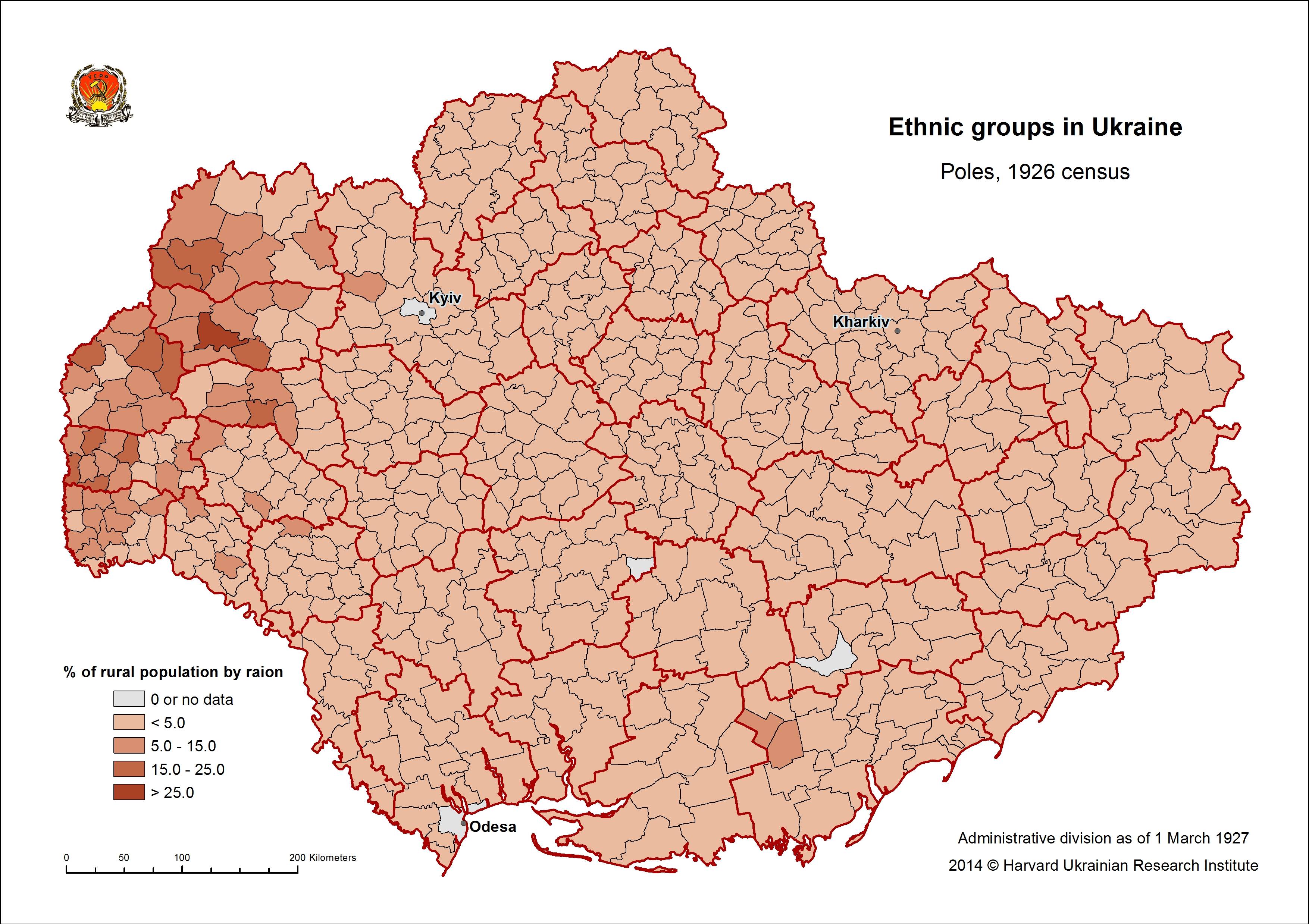 |
Poles in Ukraine were generally multilingual – they spoke several languages – Polish (including Polish dialects different from standard Polish language), Ukrainian and Russian. On the basis of data of the population census dated 1926, it is impossible to specify which part of Poles in Ukraine knew Polish language. The outcomes of the census quoted which language has been pointed as a mother tongue, which is not synonymous to the information about knowledge or lack of knowledge of the Polish language. In Ukraine, Polish has been recorded as mother tongue for over 44% of Poles, Ukrainian as mother tongue for over 48% of Poles and Russian as mother tongue for nearly 7% of Poles. The census of 1926 furthermore determined that the illiterates prevailed among the Polish population (51,8%). Among the literate Poles, there was a part who did not know written Polish, but they knew Ukrainian or Russian (Kawecka 1971, 54).
The communists, who arrived from the USSR to Poland, constituted a sparse group. They took active part in the establishment of the authority structures and the communist propaganda aimed at the Polish population. The fate of some of them was tragic – they became victims of Stalin's repressions in the 1930s. It also relates to the writers and columnists residing in the USSR, with the most famous Bruno Jasieński, sentenced and executed in 1938. Even the text he published in "Sierp" [Sickle] (1931/2, p. 3), admitting his "mistakes", did not save Witold Wandurski – the organiser of the Polish theatre in Kiev, from being executed.
The propagandist activity among Poles in Ukraine was conducted inter alia by means of the system of schools with Polish, and the press published in Polish. Polish-language education for children and adults was to eliminate illiteracy and bring the knowledge of written Polish into general use. Further stages of the Soviet policy towards ethnic minorities, including the Polish minority, denoted the transition from the initial policy of the so-called korenizatsiya (Russian: reaching into the roots) in the 1920s, to the Stalinist terror and repression of the 1930s, including the so-called Polish Operation of the NKVD (1937–38). The Julian Marchlewski Polish Autonomous District, settled in Volhynia in 1925, was resolved in 1935. Schools with Polish language were gradually closed (the last ones survived until 1938), Polish-language periodicals – the most known Kiev "Sierp", seized to be published in 1935. Historians estimate that different forms of Stalinist repressions in the years of 1929–1939 (deportations, prisons, work camps, executions) afflicted 150–200 thousand of Poles in Ukraine, i.e. nearly 1/3 of the Polish population (for the details of the history of Poles in the Soviet Ukraine in 1918–39 see: Iwanow 1991, 2014; Kupczak 1994; Стронський 1992; Stroński 1998). The 1930s have also been distinguished by the final hit in the Roman Catholic Church, which gathered the Polish population. 220 Roman Catholic churches provided their pastoral service insofar as 1927. Still until 1933, half of the churches have been closed and most of the priests arrested. The elimination of the Roman Catholic Church was completed in 1937 – there was not a single functioning church left, and the clergy were subject to repressions (Iwanow 1991, 228; Stroński 1998, 79; Dzwonkowski 2005, 284).
2. The functions of press – propaganda
The press published in Ukraine in Polish in the 1920s and the 1930s was a part of the party-Soviet press established after the Bolshevik Revolution in 1917. In the course of 1917–20, a completely new press system, functioning in the conditions of single party leadership and censorship, was introduced in Russia and the Soviet republics (Овсепян 1999, 16–35). The centers of power – the committees of the Bolshevik party on different levels of central and regional administration and the communist organizations grouping for example children and youth were the publishers. During the period of the domestic war (1917–22), the Red Army was an essential publisher.
During the 1920s and the 1930s, it was the press that was the basic means of communication of the Bolshevik authorities with the public. It also informed the representatives of the authorities in the provinces and the activists on site, about current tasks and the binding political line of the party (Lenoe 2004, 46, 72). The central space has been occupied by the Moscow titles "Pravda" (Russian: Правда) – the organ of the Central Committee of the Communist Party ant the governmental "Izvestia" (Russian: Известия), setting the tone for the whole press, including press published in the languages of the minorities. The Soviet titles appeared in national languages just after the Bolshevik Revolution in 1917 – there were 20 of them in 1918 (McNair 1991, 49). The central Polish-language title issued in Moscow was "Trybuna Radziecka" [The Soviet Tribune], in Ukraine "Sierp" (Kiev) was published on the republican level, in Belarus "Młot" [Hammer] – since 1926 under the title of "Orka" [Plowing] (Minsk) (for periodicals in Belarus cf. Grek-Pabisowa, Ostrówka, Biesiadowska-Magdziarz 2008).
The Polish-language papers served the propaganda of the current slogans of the communist party, fulfilling the next political and economic priorities. Through the agency of the press, a new political language promulgated among the communist activists. The only non-politicised texts were e.g. the columns with agricultural guidance published in "Sierp" – Agricultural economy or the Agricultural Guide, or the popular and scientific sections, such as Interesting Things in "Głos Młodzieży". In relation to the described periodicals, a distinction between the political and the information press as opposed to the magazines, accepted e.g. in the studies of press published at that time (1918–39) in Poland shall not apply (for press in Poland cf. Paczkowski 1980).
The titles from 1918–22, issued during the period of war on settlement of the Soviet command, focused inter alia on discussing the territory gains of the new authority, and during the Polish-Bolshevik war (1919–21), on the anti-Polish agitation, aimed at the Polish state, presented as bourgeois and aristocratic. The end of the 1920s was marked with an increase of the tension among the Polish rural population, in relation to the introduction, in 1929, of compulsory collectivisation, which meant the elimination of individual farms and incorporating their lands and property into kolkhozes. A dozen or so local Polish-language titles have been created at that time, which helped the priority mobilisation action of the rural population, in order to accelerate collectivisation. An aggressive "anti-kulak" propaganda addressed against the wealthier peasants (kulaks), recognised as the class enemies, who have been subject to mass terror, has been realised. Following the model of industrialisation in cities, in the press directed to peasants, there have been calls for discipline and increase in the achievements in particular kolkhozes, by organising inter alia the "work competition" among the kolkhozes. These are the beginnings of "socialistic competition", known during the post-war decades and during the times of the Polish People's Republic as well as in other satellite states of the USSR. The press texts from the early 1930s are filled with the military lexicon: front 'front' (e.g. front of the socialistic construction), kampania 'combat' (e.g. sugar beet harvest combat), szturmowość 'storming' (Russian: ударничество 'super-productivity of work, one of the forms of competition'), walka 'struggle' (e.g. struggle for the quality of production), zwycięstwo 'victory' (e.g. victory of the working masses). The vocabulary used to name people recognized as internal enemies was extensive: element 'element' (petit bourgeois elements, foreign elements), klecha 'clergyman (pejorative)', kułak 'kulak' (also: kulak henchman, kulak survivor, kulak confidant), łazik 'absentee, loafer' (Russian: прогул 'worker leaving work with no excuse; loafer'), nepman 'nepman' (Russian: нэпман 'a trader in the period of NEP'), pasożyt 'parasite', spekulant 'speculator', szkodnik 'vermin', wróg 'enemy' (class enemy, nation enemy, workpeople enemy).
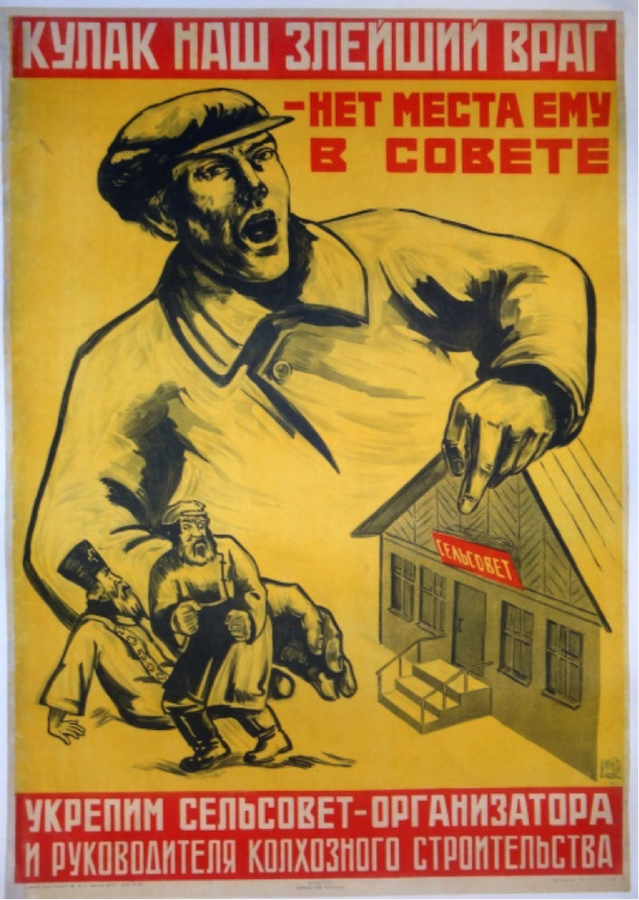 |
Illustration 1. A Soviet propaganda poster, artist unknown, Kiev 1930. Inscription: "Кулак наш злейший враг – нет места ему в совете. Укрепим сельсовет-организатора и руководителя колхозного строительства" ("Kulak is our worst enemy – there is no place for him in the council. Let us strengthen the country council – the organizer and the leader of kolkhoz construction"). Source: http://redavantgarde.com |
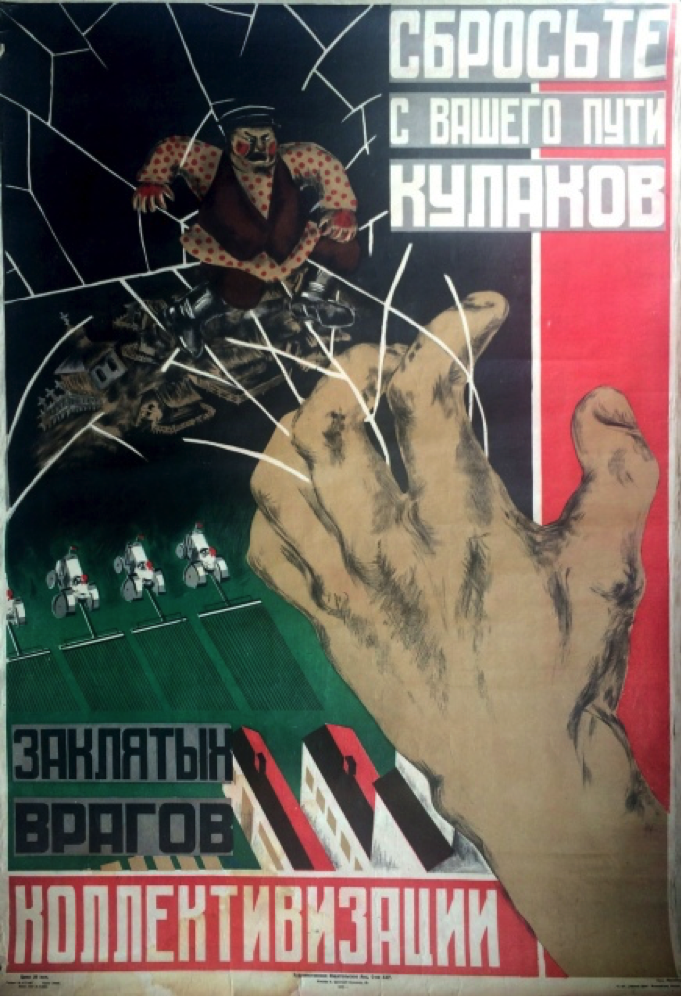 |
Illustration 2. Soviet propaganda poster, artist: Ariadna Maguidson (Solomonovna), Moscow 1930. Inscription: "Сбросьте с вашего пути кулаков / Заклятых врагов коллективизации" ("Throw kulaks off your way / The damned enemies of collectivization"). Source: http://redavantgarde.com |
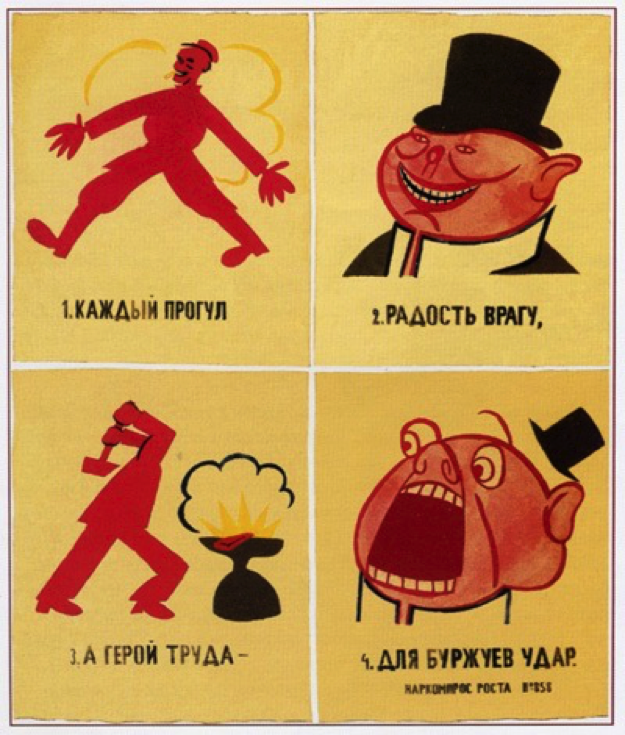 |
Illustration 3. Soviet propaganda poster, artist: Vladimir Mayakovsky, Moscow 1920. Inscription: "Каждый прогул / радость врагу, / А герой труда – / для буржуев удар" ("Every vagrant / joy to the enemy, / And the hero of work – / a hit to the bourgeois"). Source: http://www.plakaty.ru |
The counterweight was the names of people presented as the heroes of the era: bohater ‘hero’ (e.g. hero of the socialistic construction), bojownik ‘fighter’ and bojowniczka ‘fighter, female’ (e.g. communism fighter), szturmowiec ‘stormtrooper’ and szturmowczyni ‘stormtrooper, female’ (Russian: ударник ‘stormtrooper’, ударница ‘stormtrooper, female’, e.g. stormtrooper of the socialistic fields). The Soviet sportsmen, travellers, pilots have also been the positive heroes, whose achievements have been reported in detail. In 1928–29, the action of self-criticism, which enabled the workers, peasants and the lower representatives of authorities to criticise the party officials and administration, found its reflection in articles. In 1933, the resounding case of arresting a group of top Polish communist activists, columnists and editors of the Polish-language newspapers, on fabricated charges of espionage for Poland, including Bronisław Skarbek-Szacki, shot in 1934, was discussed in the press. A neologism describing this group - skarbkowszczanie [deriving from the name of Skarbek-Szacki], and for their supposed espionage activity called skarbkowszczyzna, appeared in texts. In 1935, as a part of another purge, the leadership of the Julian Marchlewski Polish Autonomous District was removed from the party, what was broadly commented in "Sierp", stigmatising the kulak policy developed in the Polrajon (1935/28, p. 2).
The contents presenting the Soviet reality in an adverse light were consequently not published in papers. The lack of information about the tragedy of the great famine of the 1932–33 (Ukrainian: Голодомор), which caused millions of victims – the estimates of the Harvard Ukrainian Research Institute indicate nearly 4 million death victims in Ukraine, is symptomatic. The famine has been the consequence of the USSR authorities’ policy, and was recognised by Ukraine and other countries as genocide. The most severe loss was suffered by the region of Kiev and Kharkov.
|
Map 2. Human losses due to the famine in Ukraine in 1932–34, division into regions. Source: gis.huri.harvard.edu. Courtesy of Harvard Ukrainian Research Institute |
 |
The fight against religion also escalated in the press, including the one against the Roman Catholic Church. The press articles called for active anti-Catholic work, informed about the activity of the atheist associations, atheist circles and the anti-religious and atheist corners (arranged e.g. in the reading huts). In Moscow, an anti-religious Polish-language periodical "Bezbożnik Wojujący" [Militant Atheist] (1929–35) was published (cf. Sierocka 1968, 58), the equivalent of the Russian title „Безбожник” (1922–41) and „Безбожник у станка” (1923–31).
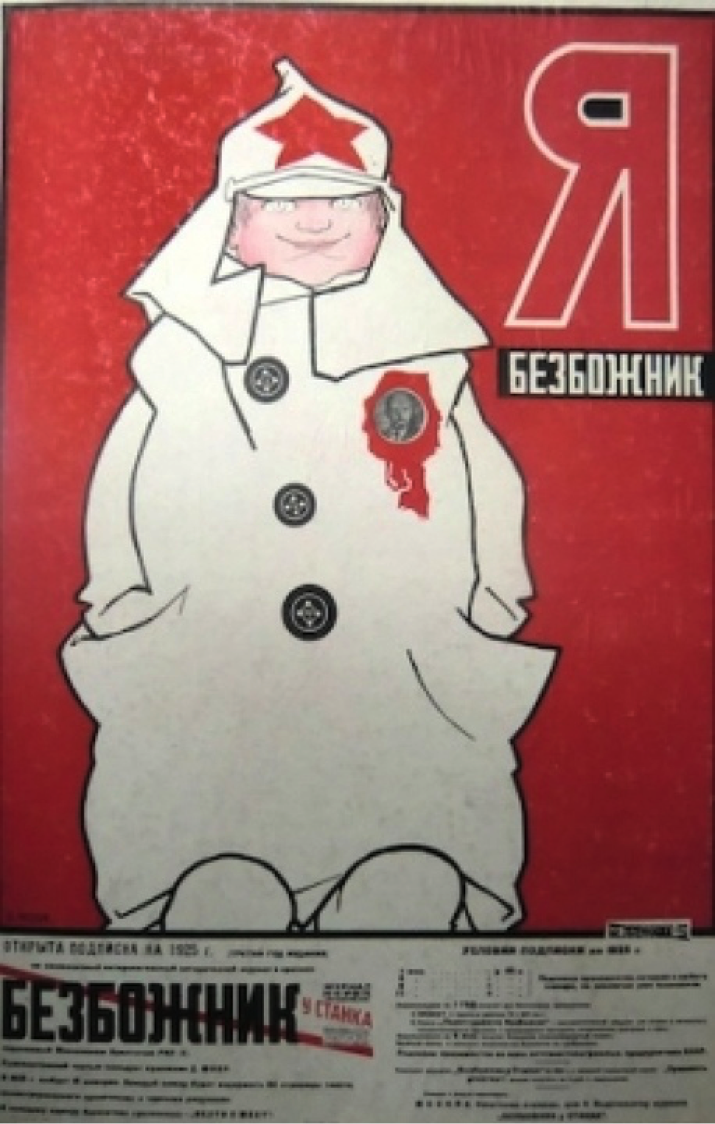 |
Illustration 4. Soviet propaganda poster, artist: Dmitry Moor (Orlov), Moscow 1924. Inscription: "Я безбожник" ("I – the atheist"). Source:http://redavantgarde.com |
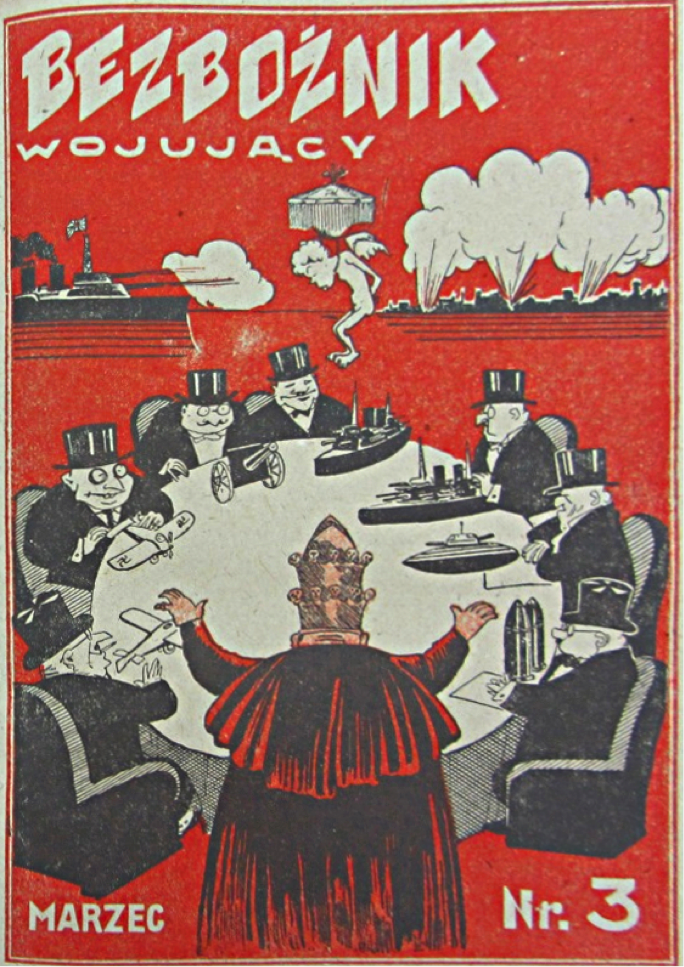 |
Illustration 5. The front cover of the Polish-language magazine – "Bezbożnik Wojujący" [Militant Atheist] issue number 3 from 1932, Moscow. Photo: Lyudmyla Yanushevska |
3. The functions of press – organisation for people, correspondent movement
Apart from acting as a medium of agitation and propaganda, the press was to serve as an organiser of social life. The inspiration came from the famous sentence by Włodzimierz Lenin: "A magazine – is not just a collective propagandist and collective agitator, but also a collective organiser" (1901, Where to start?).
A crucial role in achieving this objective was played by the correspondent movement, constituted by the Bolshevik party, which was a network of correspondents sending their texts to the newspapers from the region. In place of the journalists-reporters, texts of amateur correspondents (working class and rural), acting accordingly to the guidelines of the editing offices of particular titles, appeared in the Bolshevik press. The press system was based on the work of the newspapers' editors, publishing information derived from the Soviet information agency (ROSTA, later TASS) and the chosen information sent by the correspondents. The novelty was not the publishing of correspondence in the press itself, but the character of the correspondent movement, organised and controlled by the authorities (Kenez 1985, 231, 233).
Numerous signals, indicating the significance the editing offices put on the development of correspondent movements, appeared in the press published in Polish. In press texts, apart from the lexeme correspondent, a number of new ones have appeared, corroborating the extent and specialisation of the correspondent movement: junkor 'young correspondent', korespondent dziecięcy 'child correspondent', leskor 'correspondent of the silviculture', młodociany korespondent 'juvenile correspondent', pikor // pionkor 'pioneer correspondent', robkor 'working class correspondent', robwiejskor // robwiejkor 'working class-rural correspondent', szkołkor // szkolkor 'school correspondent', ścienkor 'wall newspaper correspondent', wiejskor // wiejkor 'rural correspondent'.
The activity of the correspondents did not restrict to sending letters to newspapers. Their role was an active political and organisational performance in the region, and supervision over the implementation of the authorities' guidelines.
The central Polish-language newspaper in the Ukraine – "Sierp" – after over 2 years from its establishment published a text about the role of the working class and rural correspondents in the development of the title. In the article under the motto: "Working class and rural correspondents - are the eyes and ears of the state of the working ones" (1925/1, p. 11), the editorial office notifies that "Sierp" already gathers 100 correspondents, the magazine obliges itself to lead this team, help the correspondents in education and fulfilment of tasks in their regions. "In the example of »Sierp«, the words of comrade Lenin, who always taught us, that – »the newspaper will be interesting and full of life only then, when for each 5 journalists (i.e. the long-standing workers of the editorial offices) there are 500, or even 5000 non-journalists (i.e. the working class and manor correspondents« proved true". One of the forms of supporting the correspondents is the constituted together with the 1 issue of the 1925, new division named The Correspondent Corner, including inter alia practical suggestions about the recommended subjects and form of correspondence. "The task of this division is to lead the work of the robkors and sielkors, teach them about what to write and how to write it for the newspaper, in order to contribute to the elevation of their general and political knowledge, to point how to fight the kulaks and counter-revolution, illiteracy and superstition, abuse and injustice, to be advisers of the correspondents in their social work and Soviet construction and building, to inform the correspondents of how their letters have been used, to enlighten the tasks of the »Sierp-lovers circles« and the like".
The arrangements concerning the status of the correspondent included inter alia, the financial questions – there has been no reward for the correspondence: "The correspondent, as an honoured collaborator of the Editorial Office, does not receive any reward for the correspondence". It also happened that some titles awarded prizes to the most active correspondents.
The editorial office of "Sierp" certified the correspondent's right to not to disclose their names: "The Editorial Office keeps the name of the correspondent in secret (if he demand so) and signs the correspondence with a pseudonym indicated by the correspondent. The submission of personal data (name and address) has been required to the knowledge of the editorial office, and a group of a qualified team of regular correspondents of the paper filled the personal data questionnaires. Though in practice, anonymous reports were admitted to publication, with a remark that it is an exception to the common practice.
The way of using the delivered materials was clearly presented, including the submission of the materials to the appropriate organs of authority: "The Editorial Office uses each delivered correspondence, some of it is printed in the paper, some is sent to appropriate Soviet or party institutions to be verified, the other is collected by the Editorial Office, who on the basis of this correspondence, writes articles".
"Sierp" then organised The First Meeting of the Correspondents of "Sierp" (January 1926) with a presence of 60 correspondents, and also, published a brochure The rural correspondent guide (1926). The agitation and organisational efforts of "Sierp" fruited with the development of the correspondent movement. The magazine gives the illustrative statistics: in 1925 the magazine had 134 of regular correspondents, and 365 wrote sporadically (1926/4, p. 3); in 1926, 519 people wrote to the magazine and sent 2250 letters in total (almost 190 letters a month), out of which 999 letters have been published and 65 articles have been written by the correspondents (1927/3, p. 6) The Second Meeting of the Correspondents of "Sierp" (January 1928) was organised on a smaller scale than the first one, only about 20 correspondents were invited (1926/4, p. 3; 1928/5, p. 7).
The central Polish-language magazine in Ukraine was followed by magazines for children and the youth, including the most known "Głos Młodzieży" – an organ of the komsomol. Already, in the first issued number dated 1925 (1925/1, p. 1), the periodical encourages to send correspondence: "The Editorial Office calls for the Polish youth organisations, as well as Polish workers and small farmers of Ukraine, to get involved, send correspondence about their work and life, as well as articles, poems and their remarks on the deficiencies of the magazine". "Głos Młodzieży", just like "Sierp", introduced a division The Correspondent Corner, in which it provided advice about the contents and form of the delivered texts and published the replies given to correspondents. The magazine determined the number of its long-standing correspondents, at the beginning of 1926, to be 70, and the number of delivered letters to be 60–80 (1926/2, p. 2). In further yearly overviews, the development of the correspondent movement is visible: in 1927, the magazine had about 150 correspondents. As far as in 1926, there was a flow of 615 pieces of correspondence, then in 1927, there were even 3000 (250 a month in average). The editorial office informs, that in 1927, about 1/4 of the issues are filled with correspondent's texts (1927/2, p.2; 1928/1, p.4). Also the periodical issued by the organization of pioneers – "Sztandar Pioniera" – from the very first issues calls to organise the child correspondent movement: "Each pioneer division, children's house, school, should choose correspondents at their next meeting (it is better that they offer themselves voluntarily). They should set themselves to work immediately and write to the editorial office of "Sztandar Pioniera", and other junior magazines, about the life of their collective" (1924/4–5, p. 10).
The local (regional) papers, established in the early 1930s, due to the action of collectivisation in the rural areas, emphasised the political commitment of the rural correspondents. Articles sharp in tone have presented the correspondents with precise tasks: "The robwiejkors should follow, unmask the class enemy's endeavours - kulaks, petliurans [followers of Petliura] and their supporters – who try to infiltrate into the organs of the proletariat dictatorship" ("Szturmowiec Pól" 1934/117, p. 1). The task of the rural correspondents was also to engage in the current economic plans, such as organising the socialistic competition between particular kolkhozes, mobilisation of people to the current industrial and rural campaigns. The movement of correspondents has also been entrusted with supervision of the quality and timeliness of economic tasks, organisation of touring brigades of rurcors, who perform control trips (tours) on site.
One of the instruments of supervision over the correspondent movement and submission of the current guidelines of the authorities, are the assemblies (congresses, meetings) of correspondents organised by the periodicals. These are the meetings on different levels – from meetings of the correspondents writing to a particular title, through regional to the interregional ones. There have been correspondent circles and correspondent precincts (e.g. in factories, kolkhozes, schools), established on site, which had to collaborate with the press and fulfil the assigned tasks among the population.
4. The functions of press – control of the people
The collaboration of the papers with the correspondents created the conditions to control the people. The development of the correspondent movement enabled the authorities to view the public sentiment and the reactions to particular political moves. The delivered materials, according to the guidelines of the editorial office, did not only describe the events, but also gave the names of people, including the names of people who were blamed for particular situations. So, the correspondence also had a denunciation character. The essential value of the correspondent movement, from the point of view of the authorities, was its widespread presence in the USSR, since 1923–24, it developed intensively, taking up further challenges. The correspondent denunciation has been used by the organs of state control since the very beginning (Nérard 2008, 49–50). In the fashion of practice in the Russian-language press (Nérard 2008, 97–8), the correspondent denunciations, in the papers published in Polish, have been expressed by means of lexemes deprived of negative connotations. The word sygnały ‘signals’ (in plural) has been particularly used, which popularised in the press of the 1930s. Furthermore, the pejorative donos ‘denunciation’ has been used in the press texts only in the historical (pre-revolutionary) context. A substantial part of periodicals has been devoted to the correspondent's materials, regular columns publishing the correspondence, e.g. The robwiejkor's signals; The signals of the robwiejkors.
As far as the names of the people encumbered with blame have been made public, sometimes even highlighted in print, the authors of the denunciations had the right to remain anonymous – their signatures under the correspondence usually had the character of pseudonyms. The editorial houses explicitly instructed the correspondents to point out particular people – the causers or the responsible ones in reported cases. On the other hand, there came the texts indicating the fears of the periodicals' editorial houses, that the correspondents act as spies in the local populations. "Głos Młodzieży" from 1928 warns the correspondents against such activity: "It quite frequently happens that the correspondent tries to see only the bad sides in this or that domain of the social work, tries to enlarge the meaning of these deficiencies on purpose, follows after the individual workers and thus, gradually transform the correspondent's work into espionage" (1928/1, p. 7).
The press also realised the interventionist function. The cases reported by the correspondents were forwarded to the organs of authorities on an appropriate level, there was an expectation of the authorities' intervention. Information on the further fate of the denunciations submitted in letters could be found in the press, including the information on the prosecution of the particular people called by their names. In each title, regular columns have been created, devoted to this matter, i.e. Following the signals, Following the correspondence. The prosecutor's statements, concerning the reported means of the press cases, have also been published. Furthermore, it is essential that the information delivered by the correspondents was not verified before the publication, and the authors of the untruthful judgements did not bear any consequence.
In the Soviet system, the denunciations to the press have been used not only for the repressive purposes, but also as a means of monitoring the public sentiment. On the basis of the correspondence delivered to the papers, consolidated reports have been made and addressed to the authorities of different levels, including the heads of state. The investigating authorities had the duty to analyse the press news, and thereupon, to start the investigation on its own initiative (Nerard 2008, 153–5, 174). The role of the press in the USSR, in propagation of actions of placing complaints and denunciations, was of prior importance, it enabled this practice to be popularised among the society and to break the resistance against the denunciation. A wave of denunciation has mounted especially during the years of "the great terror" (1937–38) (Conquest 1997, 380).
5. Press readership and distribution
As mentioned, the data of the population census of 1926 show that about half of Poles were illiterate, but among the literate ones, only a part knew Polish in writing, the other part – other language (Russian or Ukrainian). Despite the efforts of the Polish-language education, particularly active in 1925–35, the low level of literacy of the society limited the number of potential readers of the press published in Polish.
The distribution of the Polish-language periodicals was conducted via subscription, in particular a collective subscription, i.e. several copies of a title were subscribed by the individual administrative, educational and political institutions, such as Polish rural councils, schools, reading-huts, likpunkts ('the spots of illiteracy elimination'), pioneer and komsomol organisations. The calls for subscription of periodicals, for enrolment of new readers, have regularly appeared in the press texts, and contests with awards for subscribers have also been announced. Reading newspapers together has also been promulgated, and the circles of readers have been established. The most popularised ones were the Sierp-lovers circles – gathering the readers of "Sierp", they were then combined with the circles of readers of other newspapers into a uniform circles of book and newspapers friends. At the meetings, except for the collective reading, the read texts have been discussed, and the letters to editorial offices have been written.
The republican "Sierp" and "Głos Młodzieży" had the largest coverage. Polish-language newspapers issued in Moscow have also reached Ukraine, particularly "Trybuna Radziecka". The statistical overviews from that period show that in Ukraine the circulation of Polish-language papers was significantly lower than that of papers in other languages of ethnic minorities - Jewish and German. For example, in 1930, the biggest one-off circulation of the central "Sierp" was 7.4 thousand copies, 3 thousand copies of the "Bądź Gotów!" magazine, whereas the Jewish titles: "Zei Greit" – 28 thousand, "Der Sztern" – 15 thousand, German in turn: "Die Trompette" – 15,7 thousand, "Das Neue Dorf" – 13 thousand (Kupczak 2001, 17).
|
Graph 1. Polish-language periodicals in the Soviet Ukraine (1918–39) with the biggest number of issued copies |
 |
| Source: own study; Daszkiewicz 1966. |
The readership of the Polish-language press was limited not only because of the low circulation, but the difficult language of the press texts has also been an obstacle, particularly the flow of the new political lexis. The situation was similar in case of the reception of the party-Soviet press in the USSR. The survey on the knowledge of that lexis in Russian rural areas, carried out in 1923, showed the ignorance of even the most common abbreviations as CCCP (USSR) and the mistake in relation to the meaning of many lexemes, such as Russian: пленум (‘session’) and Russian: плен (‘captivity’), etc. The peasants complained that they would need a translator in order to understand the press texts (Kenez 1985, 256). Undoubtedly, the network of the Polish-language press had an impact on the distinguished group of readers, i.e. on the local political activists.
The specificity of the party-Soviet press in the USSR was the existence of another press circle – the factory newspapers, wall newspapers, field newspapers (fields), in particular factories, schools, kolkhozes. Their establishment was treated as a way of mobilisation of the local societies.
The Polish-language press had a political influence on the Poles in Ukraine, not by the broad readership, but by organising the Polish population to fulfil the tasks placed by the authorities and the control of people by means of the on-site correspondents.
Literature
- Conquest Robert, 1997, Wielki terror, z ang. przeł. Władysław Jeżewski, Warszawa.
- Dzwonkowski Roman SAC, 2005, Z historii Kościoła katolickiego w ZSRS 1917–1991. Pogadanki w Radiu Watykańskim, Ząbki.
- Grek-Pabisowa Iryda, Ostrówka Małgorzata, Biesiadowska-Magdziarz Beata, 2008, Język polski na Białorusi Radzieckiej w okresie międzywojennym: polszczyzna pisana, Warszawa.
- Iwanow Mikołaj, 1991, Pierwszy naród ukarany. Polacy w Związku Radzieckim 1921–1939, Warszawa.
- Iwanow Nikołaj, 2014, Zapomniane ludobójstwo. Polacy w państwie Stalina. „Operacja polska” 1937–1938, Kraków.
- Kawecka Krystyna, 1971, Szkolnictwo polskie w ZSRR w latach 1921-1930, „Rozprawy z Dziejów Oświaty” 14, s. 43–76.
- Kenez Peter, 1985, The Birth of the Propaganda State: Soviet Methods of Mass Mobilization, 1917–1929, Cambridge.
- Kupczak Janusz, 1994, Polacy na Ukrainie w latach 1921–1938, Wrocław.
- Kupczak Janusz, 2001, Prasa i książki polskie na Ukrainie Radzieckiej w latach 1920–1939, „Literatura Ludowa” nr 6, s. 17–24.
- Lenoe Matthew E., 1998, Agitation, Propaganda, and the "Stalinization" of the Soviet Press, 1922–1930, Pittsburgh.
- Lenoe Matthew E., 2004, Closer to the Masses: Stalinist Culture, Social Revolution, and Soviet Newspapers, London.
- McNair Brian,1991, Glasnost, Perestroika and the Soviet Media, London-New York.
- Nérard François-Xavier, 2008, 5% prawdy: donos i donosiciele w czasach stalinowskiego terroru, z fr. przeł. Janina Szymańska-Kumaniecka, Warszawa.
- Paczkowski Andrzej, 1980, Prasa polska 1918–1939, Warszawa.
- Sierocka Krystyna, 1968, Polonia radziecka, 1917–1939: Z działalności kulturalnej i literackiej, Warszawa.
- Stroński Henryk, 1998, Represje stalinizmu wobec ludności polskiej na Ukrainie w latach 1929–1939, Warszawa.
- Овсепян Рафаил П., 1999, История новейшей отечественной журналистики (учебное пособие), под редакцией Я.Н. Засурского, Москва.
- Стронський Генріх, 1992, Злет і падіння. Польський національний район в Україні у 20-30-ті pоки, Тернопіль.
